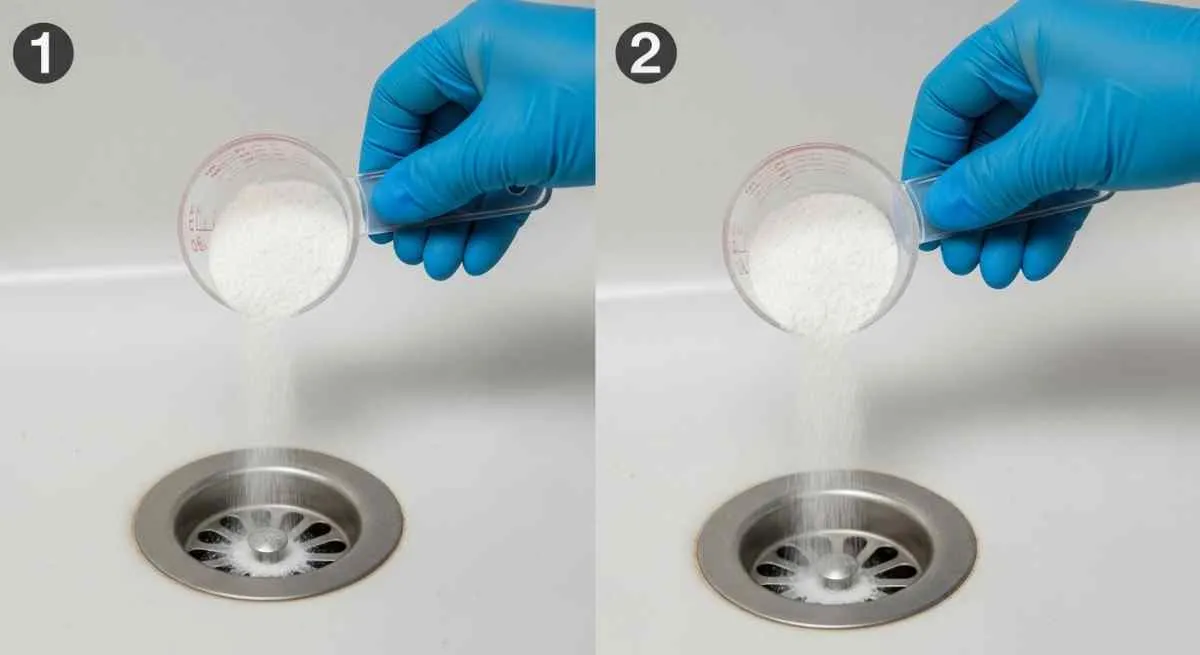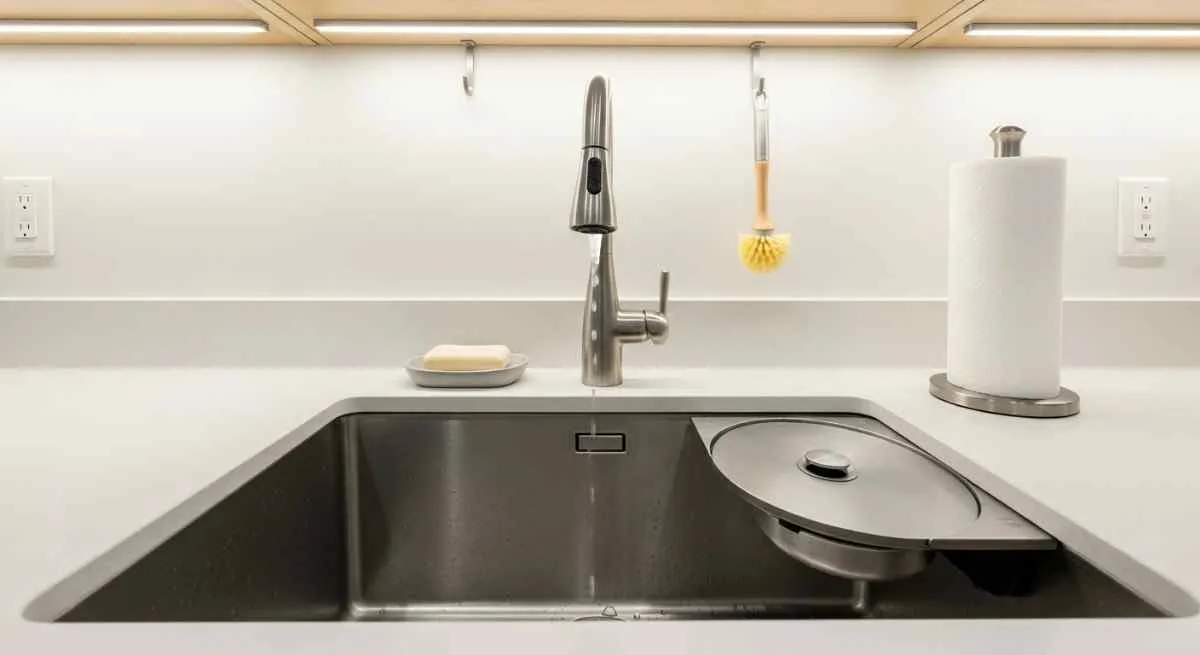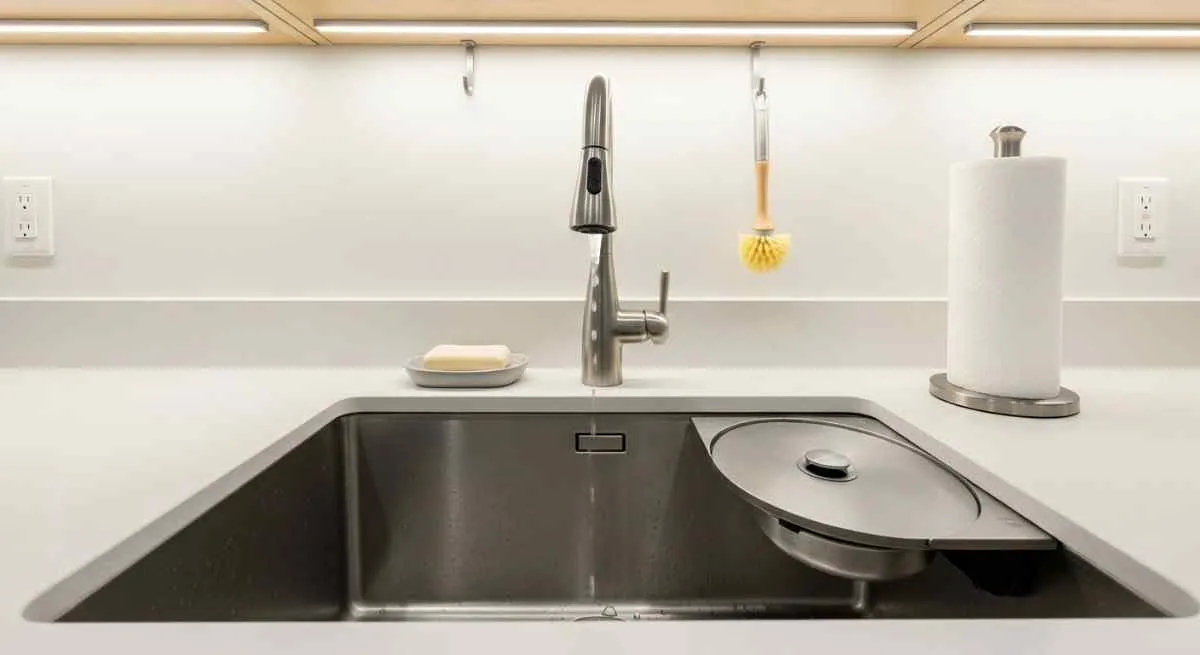Introduction: The Unwelcome Midnight Kitchen Visitor
You walk into your kitchen for a late-night glass of water, flip on the light, and freeze. There, scrambling across your kitchen sink, is a cockroach—or worse, several. Your mind races with questions: Where did they come from? How did they get into my clean kitchen? And most importantly, how do I make sure this never happens again?
Discovering roaches in your kitchen sink is one of the most unsettling experiences homeowners face. Unlike roaches spotted on countertops or floors that might have wandered in from outside, roaches emerging from drains suggest a more persistent problem—one that requires understanding the unique ways these pests exploit your plumbing system.
This comprehensive guide explains why roaches appear in kitchen sinks, how they navigate drain systems, and most importantly, what you can do about it. We’ll explore both DIY solutions and professional interventions, discuss prevention strategies that address root causes rather than just symptoms, and help you understand when a simple cleaning routine is sufficient versus when you need expert help.
Whether you’re dealing with an active infestation or want to prevent roaches from ever discovering your drains, this article provides the practical, science-based information you need to reclaim your kitchen.
Understanding Why Roaches Choose Kitchen Sinks
The Perfect Pest Environment
Kitchen sinks provide everything cockroaches need to survive: water, food, shelter, and darkness. Understanding why these elements make drains attractive helps you develop effective prevention strategies.
Water is essential for cockroach survival. While these pests can survive weeks without food, they need water every few days. Kitchen sinks offer consistent moisture, from residual water in drains to condensation on pipes. Even a small amount of standing water in a drain provides sufficient hydration for multiple roaches.
Food sources in kitchen drains are more abundant than most homeowners realize. Grease buildup on pipe walls, food particles that wash down during dishwashing, organic matter accumulating in garbage disposals, and biofilm coating drain surfaces all provide nutrition. Roaches aren’t picky eaters—they’ll consume soap residue, hair, and decomposing organic material that accumulates in plumbing systems.
Shelter and harborage areas within plumbing systems protect roaches from predators and environmental threats. The dark, confined spaces inside pipes, the areas behind garbage disposals, gaps around pipe penetrations through cabinets, and spaces where pipes meet walls all offer hiding spots where roaches can rest during daylight hours.
Temperature regulation is another advantage drains provide. Pipes carrying warm wastewater maintain temperatures roaches find comfortable, while the insulated environment protects them from extreme temperature fluctuations.
Common Roach Species Found in Drains
Not all cockroaches interact with plumbing systems the same way. Understanding which species you’re dealing with helps determine the most effective treatment approach.
German cockroaches are the most common indoor species and frequent drain visitors. These small, light brown roaches with two dark stripes behind their heads thrive in warm, humid environments. German cockroaches typically measure half an inch to five-eighths of an inch long and reproduce rapidly—a single female can produce up to 400 offspring in her lifetime. They prefer kitchen areas and are often found in and around sinks, dishwashers, and food preparation areas.
American cockroaches, sometimes called “sewer roaches” or “water bugs,” are larger roaches that commonly enter homes through drain systems. These reddish-brown insects can reach up to two inches in length and are strong fliers. American cockroaches often live in sewer systems and enter homes through floor drains, particularly in basements, but can also emerge from kitchen sinks in severe infestations or when sewer systems experience flooding or disruption.
Oriental cockroaches are dark brown to black roaches about an inch long that prefer cool, damp environments. They’re commonly found in basements, crawl spaces, and areas around plumbing fixtures. While less likely to be seen in kitchen sinks than other species, they can enter through drain systems, particularly those connected to basement plumbing.
How Roaches Navigate Drain Systems
Cockroaches are remarkably adaptable creatures with physical capabilities that allow them to exploit plumbing systems in ways that surprise many homeowners.
Their flat, flexible bodies allow roaches to squeeze through openings as narrow as one-sixteenth of an inch—smaller than a dime’s thickness. This ability means they can navigate the gaps around pipes, slip past drain covers, and move through cracks in plumbing fixtures that appear too small to accommodate them.
Roaches climb vertical surfaces easily using tiny hooks and adhesive pads on their legs. They can scale smooth pipe walls, climb against water flow, and navigate complex pipe configurations that would challenge other pests. This climbing ability means roaches can travel upward through drain systems from sewers or septic tanks, emerging in upper-floor sinks.
Their attraction to moisture and organic matter leads them naturally toward drain systems. Roaches follow moisture gradients and scent trails left by other roaches, creating highways through plumbing that multiple roaches travel. Once a few roaches discover a favorable drain environment, others follow, potentially establishing populations within your plumbing system.
Plumbing Vulnerabilities That Attract Roaches
Several common plumbing conditions create opportunities for roaches to enter and inhabit drain systems:
Dry P-traps represent one of the most common entry points. P-traps—the U-shaped pipe sections beneath sinks—normally hold water that creates a seal preventing sewer gases and pests from entering living spaces. When sinks aren’t used regularly, water in P-traps evaporates, eliminating this barrier and creating an open pathway from sewer lines to your kitchen. Guest bathrooms, utility sinks, and seasonal homes are particularly vulnerable to dry P-trap issues.
Damaged pipe seals and gaskets deteriorate over time, creating gaps where pipes connect to fixtures, where pipes pass through walls or floors, and around garbage disposal mounting flanges. These gaps, even when small, provide entry points for roaches traveling through wall cavities or coming from other parts of the plumbing system.
Overflow drains in sinks often connect to main drains below the water level of P-traps, potentially bypassing the protective water seal. Roaches can navigate these alternate pathways, emerging through overflow openings while the main drain remains sealed.
Drain covers with large openings or missing covers provide easy access. While drain covers can’t prevent roaches from entering if they’re already in pipes, they can discourage exploration and make it more difficult for roaches to exit drains into living spaces.

Effective Solutions for Eliminating Roaches in Kitchen Sinks
Immediate Response: What to Do When You Spot Roaches
If you encounter roaches in or around your kitchen sink, immediate action can prevent a small problem from becoming a major infestation:
First, don’t panic and crush roaches near the drain. While it’s tempting to kill visible roaches immediately, crushing them can spread egg cases (oothecae) that German cockroaches carry. Instead, vacuum visible roaches if possible or trap them and dispose of them in sealed plastic bags.
Second, identify the entry point. Watch where roaches go when disturbed—do they retreat into the drain, disappear into gaps around pipes, or scatter to other areas? Understanding their movement patterns helps target treatment efforts effectively.
Third, begin a thorough cleaning of the sink and drain area. Remove dishes, clean the sink basin completely, and eliminate any food debris or standing water. This immediate cleaning reduces attractants and begins addressing the conditions that drew roaches to the area.
Fourth, inspect adjacent areas. Roaches in kitchen sinks rarely exist in isolation. Check under the sink, inside cabinets, behind appliances, and in pantries for additional signs of infestation such as droppings (small, dark, pepper-like specks), egg cases, or live roaches.
Safe DIY Drain Treatments
Several do-it-yourself approaches can help eliminate roaches from drain systems when used correctly:
Baking Soda and Vinegar Treatment
This popular home remedy can help clean drains and create an inhospitable environment for roaches, though it’s more effective as a maintenance strategy than a primary treatment for active infestations.
To apply this treatment, pour one cup of baking soda down the drain, followed by one cup of white vinegar. The resulting chemical reaction creates carbon dioxide bubbles that help dislodge organic material and biofilm from pipe walls. Allow the mixture to work for 30 minutes to one hour, then flush with hot water. This treatment is safe for most plumbing systems and can be repeated weekly as part of preventive maintenance.
While this method effectively cleans drains and removes some attractants, it doesn’t directly kill roaches and shouldn’t be considered a standalone solution for infestations. Its primary value lies in drain maintenance that reduces the food sources and organic buildup that attract roaches.
Boric Acid Application
Boric acid is a low-toxicity insecticide effective against cockroaches when used appropriately. It works by damaging roaches’ digestive systems and exoskeletons when they ingest it or walk through it.
For drain treatment, very light dusting of boric acid powder around (not inside) drain openings and in cabinet spaces beneath sinks can help eliminate roaches emerging from drains. Never pour boric acid directly down drains—it doesn’t dissolve easily and can contribute to clogs. Additionally, boric acid in water loses its effectiveness, making in-drain application pointless.
Safety considerations are important when using boric acid. While it has relatively low toxicity for humans and pets, it should be applied in areas where children and pets don’t have access. Wear gloves during application, avoid creating airborne dust, and use only the amount needed—excess application doesn’t improve effectiveness and creates unnecessary exposure risks.
Boric acid works slowly, typically requiring several days to eliminate roach populations. It’s most effective when used as part of a comprehensive approach that includes sanitation, exclusion, and ongoing monitoring.
Boiling Water Flushes
Pouring boiling water down drains can help kill roaches and their eggs while simultaneously cleaning drain surfaces. This simple, chemical-free approach has several advantages: it’s immediately available, costs nothing, poses no chemical exposure risks, and effectively clears organic buildup from drain surfaces.
To use this method, boil a large pot or kettle of water and carefully pour it directly down the drain in a steady stream. Repeat this process daily for several days when dealing with active roach problems, then continue weekly as preventive maintenance.
Important considerations: Boiling water is safe for metal pipes but should be used cautiously with PVC or plastic plumbing, as extreme temperatures can potentially damage these materials. Pour slowly to avoid splashing, and never use this method immediately after using chemical drain cleaners, as reactions could cause dangerous splashing or fume release.
Diatomaceous Earth (Food Grade)
Food-grade diatomaceous earth (DE) is a natural powder made from fossilized aquatic organisms. Its microscopic sharp edges damage roaches’ exoskeletons, causing dehydration and death.
Apply food-grade DE in dry areas around sink bases, in cabinet corners, and around pipe entry points—never directly in drains where it will become wet and ineffective. Use a light dusting; thick piles are less effective than thin coatings because roaches avoid visible concentrations.
DE is non-toxic to humans and pets when using food-grade formulations (never use pool-grade DE, which is chemically treated and dangerous if inhaled). However, avoid breathing the dust during application by wearing a dust mask, and apply it carefully to minimize airborne particles.
Professional Pest Control Options
While DIY methods work for minor problems, certain situations warrant professional pest control intervention:
When to call professionals: Consider professional help if you see roaches during daytime hours (indicating large populations), if DIY treatments haven’t reduced roach sightings after two weeks, if you discover roaches in multiple rooms or drains, if you find roach egg cases in several locations, or if you have health conditions that make DIY pesticide use inadvertent.
What professionals offer: Licensed pest control operators have access to professional-grade insecticides not available to consumers, specialized application equipment for treating wall voids and other hidden spaces, inspection expertise to identify all infestation sources and entry points, and integrated pest management (IPM) approaches combining multiple treatment methods for maximum effectiveness.
Professional treatments for drain-related roach problems typically include gel baits placed strategically around potential harborage areas, residual sprays in cabinet spaces and around pipe penetrations, dust formulations applied in wall voids and other hidden areas, and drain foaming agents that expand to treat the full pipe interior surface.
Treatment expectations: Professional roach elimination typically requires multiple visits spaced two to three weeks apart. Initial treatments focus on population reduction, while follow-up visits address newly hatched roaches and remaining adults. Most professional services include warranties or guarantees ensuring they’ll retreat if roaches return within specified timeframes.
Costs: Professional roach treatment costs vary by region, infestation severity, and home size, but typically range from $100 to $300 for initial treatment, with follow-up visits costing $50 to $100 each. While more expensive than DIY approaches, professional treatment may prove more cost-effective when accounting for time, product purchases, and the certainty of results.
Prevention Strategies: Keeping Roaches Out of Kitchen Sinks
Drain Maintenance and Sanitation
Preventing roaches from finding your kitchen sink attractive starts with consistent drain maintenance:
Daily practices should include running hot water down drains for 30 seconds after each use to flush food particles and prevent buildup, wiping sink basins dry before bed to eliminate standing water that provides overnight hydration for roaches, and using sink strainers to catch food particles before they enter drains.
Weekly maintenance should involve the baking soda and vinegar treatment described earlier, scrubbing visible drain components including stoppers and strainers with hot soapy water, and inspecting under-sink areas for leaks, moisture, or signs of roach activity.
Monthly tasks include deep cleaning garbage disposals by grinding ice cubes and citrus peels to dislodge buildup, followed by thorough hot water rinsing, checking and cleaning overflow drain openings that often accumulate debris and provide alternate entry points, and inspecting and cleaning drain covers to ensure they’re intact and functioning properly.
Eliminating Moisture and Water Sources
Since water is essential for roach survival, moisture elimination significantly reduces the attractiveness of your kitchen to these pests:
Fix all leaks promptly, including dripping faucets, leaking pipe connections under sinks, damaged garbage disposal seals, and water supply lines to refrigerators and dishwashers. Even minor leaks provide sufficient water for roach populations.
Improve ventilation in under-sink areas by ensuring cabinet doors aren’t kept tightly closed 24/7 (brief daily opening allows air circulation), considering installation of small battery-operated ventilation fans in cabinets prone to moisture buildup, and fixing any ventilation issues in kitchens with poor air circulation that contributes to condensation.
Dry sinks thoroughly each evening before bed, as nighttime is when roaches are most active. Even thin water films in sink basins provide hydration, so wiping sinks completely dry removes this resource during peak roach activity hours.
Address condensation on cold water pipes by insulating pipes that consistently collect condensation, improving general kitchen ventilation to reduce humidity, and using dehumidifiers in humid climates where condensation is persistent.

Physical Barriers and Exclusion
Preventing roaches from accessing drains involves creating physical barriers and sealing entry points:
Install quality drain covers with fine mesh or solid surfaces that close completely. While determined roaches can navigate around most barriers, proper drain covers make entry and exit more difficult, discouraging casual exploration.
Seal pipe penetrations where plumbing passes through cabinets, walls, or floors using expanding foam insulation for large gaps (then trimming and sealing with caulk once cured), silicone caulk for small gaps and cracks around pipe collars, and steel wool stuffed into gaps before sealing with caulk for a roach-proof barrier that pests can’t chew through.
Address overflow drain openings that provide alternate entry routes. Some homeowners seal overflow drains in sinks where overflow function isn’t needed, though this should be done carefully and only after considering whether overflow protection serves an important safety function.
Maintain P-trap water seals by running water in all sinks at least once weekly, pouring a small amount of vegetable oil down rarely used drains to slow evaporation (oil creates a thin film over water that reduces evaporation without eliminating the water seal), and considering P-trap primers for drains in vacation homes or rarely used facilities.
Garbage Disposal Management
Garbage disposals create unique challenges for roach prevention due to the food-rich environment inside the unit:
Run disposals properly by always using cold water when operating the disposal (cold water solidifies fats and greases, allowing them to be ground and flushed rather than coating pipe walls), running water for 15-20 seconds after grinding food to thoroughly flush particles from the disposal and drain line, and grinding ice cubes monthly to knock residue off grinder components.
Regular cleaning involves pouring a small amount of dish soap into the disposal while running cold water to clean internal surfaces, using disposal cleaning products designed specifically for this purpose monthly, and occasionally grinding citrus peels that naturally clean and deodorize while providing minimal food value for roaches.
Avoid problematic materials including grease and cooking oils that coat pipes and attract roaches, fibrous vegetables that can tangle in disposal components creating residue-trapping areas, expandable foods like rice and pasta that swell in disposal cavities, and non-food items that damage disposal components while creating harborage spaces.
Understanding Your Plumbing System’s Role
How P-Traps Protect Against Drain Pests
The P-trap—that U-shaped pipe beneath your sink—is your primary defense against pests entering through drains. Understanding how it works helps you maintain this critical barrier:
Design and function: P-traps create a water seal typically 2-4 inches deep that blocks the direct path from sewer lines to living spaces. This seal prevents sewer gases from entering homes while simultaneously blocking pest access. The curved design holds water even when drains aren’t actively in use, maintaining the protective barrier continuously.
Common P-trap problems that compromise roach protection include evaporation from infrequent use (P-traps in guest bathrooms or seasonal homes are especially vulnerable), siphonage where negative pressure pulls water from the trap (usually indicating venting problems in the plumbing system), and damage or improper installation creating gaps where the water seal doesn’t form properly.
Maintaining P-trap effectiveness requires regular use of all drains (at least weekly), monitoring for leaks that could drain water from the trap, ensuring proper venting so siphonage doesn’t occur, and considering installation of trap seal primers in rarely used drains.
Pipe Materials and Pest Entry
Different plumbing materials present different vulnerabilities to pest entry:
PVC and plastic pipes are common in modern plumbing but can develop cracks over time due to physical stress, chemical exposure, or aging. Roaches can exploit these cracks, and damaged plastic pipes should be replaced promptly.
Cast iron pipes, common in older homes, can corrode over decades, developing holes and rough interior surfaces that provide excellent harborage for roaches. Inspecting and replacing deteriorated cast iron pipes may be necessary in older homes with persistent drain pest problems.
Connection points between different pipe materials or between pipes and fixtures are vulnerable spots where seals can fail. Regular inspection of accessible connection points helps identify problems before they enable pest entry.
Inspection and Maintenance Schedule
Developing a plumbing inspection schedule helps catch problems before they facilitate roach infestations:
Monthly inspections should include visual examination of exposed pipes under sinks for leaks, corrosion, or damage, checking that P-traps contain water and aren’t leaking, testing all drains to ensure proper drainage speed (slow drains indicate buildup that can harbor roaches), and looking for moisture, mold, or water stains that indicate hidden leaks.
Annual professional inspection by a licensed plumber can identify problems not visible to homeowners, including deteriorated pipes inside walls, venting problems affecting drain function, and connection failures in inaccessible areas.
Addressing problems promptly prevents small plumbing issues from becoming pest highways. Even minor leaks or drainage problems should be repaired quickly rather than left for later attention.
Real-World Success Stories
Case Study 1: The Rental Apartment Roach Problem
When Marcus Thompson moved into a downtown apartment, he noticed occasional roaches in his kitchen sink within the first week. Despite keeping a clean kitchen, roaches appeared regularly at night, always near the sink area.
Marcus’s investigation revealed several contributing factors: the garbage disposal hadn’t been properly cleaned by previous tenants and harbored significant organic buildup, the P-trap under the sink had a slow leak that created moisture under the cabinet, and gaps around the pipe where it entered the wall provided easy access from other apartments.
His solution involved multiple steps implemented over two weeks. First, he thoroughly cleaned the garbage disposal using ice and baking soda, followed by grinding citrus peels. He tightened the P-trap connection, eliminating the leak, and sealed gaps around the pipe penetration with silicone caulk and steel wool.
Marcus also implemented a strict maintenance routine: running hot water down the drain for 30 seconds after each use, treating the drain weekly with baking soda and vinegar, and wiping the sink completely dry before bed. He applied food-grade diatomaceous earth in the cabinet under the sink and around pipe entry points.
Within three weeks, roach sightings decreased dramatically. After six weeks of consistent maintenance, Marcus hadn’t seen a roach in over two weeks. His experience demonstrates that even in multi-unit buildings where you can’t control conditions in adjacent units, proper drain maintenance and exclusion can protect your space.
Case Study 2: The Suburban Home Deep Cleaning Success
Jennifer and David Kim purchased a foreclosed suburban home that had been vacant for eight months. During their first night in the house, they discovered dozens of roaches in the kitchen, with many emerging from the sink drain.
Professional inspection revealed the primary problem: eight months of disuse had allowed all P-traps in the house to dry out completely, creating open pathways from sewer lines. Additionally, the garbage disposal had never been cleaned and contained hardened food residue, and a damaged seal around the disposal mounting allowed roaches to travel between the disposal cavity and living spaces.
The Kims hired a pest control company that applied gel baits and residual insecticides in strategic locations, implemented a comprehensive drain treatment plan using professional foaming agents, and installed fresh water in all P-traps throughout the house.
Simultaneously, they replaced the damaged garbage disposal, sealed all pipe penetrations under sinks with expanding foam and caulk, and installed fine-mesh drain covers on all kitchen and bathroom drains. They committed to running water in all drains at least twice weekly to maintain P-trap seals.
The professional pest control company made three visits over six weeks. After the third treatment, roach activity had ceased completely. The Kims continued their maintenance routine and remained roach-free. Their investment in both professional treatment and preventive infrastructure provided long-term results.
Case Study 3: The DIY Success with Persistent Effort
Rita Gonzalez, a single mother working two jobs, couldn’t afford professional pest control when she discovered roaches in her kitchen sink. She researched DIY solutions and implemented a comprehensive approach using only affordable household products and materials.
Rita’s strategy included daily boiling water flushes down all kitchen drains, weekly baking soda and vinegar treatments, application of boric acid around (not in) drain openings and in cabinet spaces, sealing visible gaps around pipes with caulk purchased from a dollar store, and installing inexpensive drain covers from a hardware store.
She also modified her kitchen habits: eliminating all standing water by drying sinks before bed, storing all food in sealed containers, taking garbage out daily rather than letting it accumulate, and cleaning the garbage disposal weekly with ice and dish soap.
Rita documented her progress with photos, noting that roach sightings decreased from 5-10 roaches nightly to 2-3 within the first week. After three weeks of consistent effort, she saw only occasional roaches. After two months, roaches were rare, appearing perhaps once every two weeks.
While her results took longer than professional treatment, Rita’s total investment was under fifty dollars for materials that lasted months. Her success demonstrates that consistent DIY efforts can effectively address roach problems when professional services aren’t financially feasible.

Pros and Cons of Different Approaches
DIY Methods
Advantages of DIY roach control:
- Cost-effective: Most DIY treatments use inexpensive household products or affordable pest control materials, with total costs typically under $50-100
- Immediate availability: You can start addressing roach problems immediately using products already in your home or quickly purchased from local stores
- Lower chemical exposure: Many DIY methods use natural or low-toxicity approaches, reducing concerns about chemical exposure to family members and pets
- Learning opportunity: Understanding pest control principles and your home’s vulnerabilities provides knowledge applicable to other pest problems
- Flexibility: DIY approaches can be adjusted and customized based on your specific situation without waiting for scheduled service appointments
Disadvantages of DIY approaches:
- Time-intensive: Effective DIY roach control requires consistent effort over weeks or months, which can be challenging for busy homeowners
- Learning curve: Understanding which products work, how to apply them safely, and what approaches are most effective requires research and sometimes trial and error
- Limited effectiveness for severe infestations: Heavy roach infestations may overwhelm DIY efforts, requiring professional intervention eventually
- Delayed results: DIY methods typically work more slowly than professional treatments, extending the period you’re living with roaches
- Potential for wasted effort: Incorrect product use or application in wrong locations can waste time and money without improving the situation
Professional Pest Control
Advantages of professional treatment:
- Expert knowledge: Licensed pest control operators understand roach behavior, know where to look for hidden infestations, and can identify species-specific vulnerabilities
- Professional-grade products: Access to more powerful and faster-acting insecticides not available to consumers
- Comprehensive approach: Professionals typically address all potential harborage areas, not just obvious problem spots
- Guaranteed results: Many pest control companies offer warranties or guarantees, providing free retreatment if roaches return within specified timeframes
- Time savings: Professional treatment requires less homeowner time investment than DIY approaches
Disadvantages of professional services:
- Higher cost: Professional roach elimination typically costs $200-600 or more depending on severity and home size
- Chemical exposure concerns: Professional treatments often use stronger chemicals that some homeowners prefer to avoid
- Scheduling constraints: You must coordinate your schedule with service appointments, and multiple visits are typically required
- Less control: You have less direct control over what products are used and where they’re applied
- Ongoing costs: Severe infestations or persistent problems may require extended service contracts with recurring monthly or quarterly costs
Frequently Asked Questions
Why are roaches coming up from my kitchen sink?
Roaches emerge from kitchen sinks because drain systems provide everything they need: water, food from organic matter and grease buildup, shelter in dark pipes, and access routes from sewer systems or other parts of your home. Kitchen drains are particularly attractive due to garbage disposal residue and food particles. If your P-trap has dried out from infrequent use, it creates a direct pathway from sewer lines to your sink. Roaches also exploit gaps around pipes, damaged seals, and overflow drains to access living spaces from plumbing systems.
Can roaches live in plumbing pipes?
Yes, roaches can and do live in plumbing systems, though they typically inhabit areas where pipes provide access to food, water, and air rather than sections continuously filled with wastewater. They commonly inhabit the interior surfaces of drain pipes where biofilm and organic matter accumulate, gaps and spaces around garbage disposals, areas behind and around pipe connections, and sections of sewer systems where they can survive on organic matter in wastewater. Roaches navigate through pipes to reach these favorable areas, which is why they can emerge from drains throughout your home.
How do I stop roaches from crawling up through my drain?
Preventing roaches from emerging through drains requires multiple approaches: maintain proper water seals in P-traps by using all drains at least weekly; seal gaps around pipes where they penetrate cabinets, walls, and floors; install drain covers that make entry and exit more difficult; keep drains clean using regular hot water flushes and periodic baking soda/vinegar treatments; eliminate food sources by properly cleaning garbage disposals and preventing grease buildup; apply boric acid or diatomaceous earth around drain openings (not inside drains); and address any plumbing leaks or damage that could provide alternate routes. Comprehensive prevention typically proves more effective than focusing on a single method.
Is boric acid safe for kitchen drain treatment?
Boric acid should never be poured directly into kitchen drains. While boric acid is effective against roaches, it doesn’t dissolve well in water and can contribute to drain clogs. Additionally, boric acid loses effectiveness when wet, making in-drain application pointless. Instead, apply boric acid as a light dust around drain openings, in cabinet spaces beneath sinks, and around pipe penetrations—areas where roaches travel but where the product remains dry. When used this way, boric acid is relatively low-toxicity but should still be applied carefully in areas where children and pets don’t have access. Always wear gloves during application and avoid creating airborne dust.
Do I need to seal drain gaps to prevent roaches?
Yes, sealing gaps around drains and pipes is an essential prevention step. Roaches can squeeze through openings as small as one-sixteenth of an inch, so even small gaps provide entry points. Focus on sealing where pipes penetrate cabinets and pass through walls or floors, around garbage disposal mounting flanges and connections, between pipe sections where connections may have degraded seals, and around P-trap connections that may have loosened over time. Use silicone caulk for small gaps, expanding foam for larger openings (trimmed and sealed with caulk once cured), and steel wool stuffed into gaps before sealing as a roach-proof barrier. Proper sealing not only prevents roach entry but also protects against moisture damage and improves energy efficiency.
How often should I clean my kitchen drain to prevent roaches?
Implement a multi-level cleaning schedule for optimal roach prevention: daily hot water flushes (30 seconds after each use) to prevent food particle buildup; weekly baking soda and vinegar treatments to clean pipe surfaces and remove organic matter; monthly deep cleaning including garbage disposal maintenance with ice and citrus peels; and quarterly inspection of all under-sink components including P-traps, connections, and seals. This regular maintenance prevents the organic buildup and moisture conditions that attract roaches while also helping you catch plumbing problems early.
Can roaches survive boiling water poured down drains?
Boiling water kills roaches and their eggs on contact and can be an effective treatment for roaches visible in drains or known to be inhabiting the upper portions of drain pipes. However, boiling water’s effectiveness is limited to the immediate drain area—it cools rapidly as it travels through pipes and won’t eliminate roaches deeper in the plumbing system. Boiling water also doesn’t provide residual protection; roaches can return once the water cools. Use boiling water as part of a comprehensive approach including drain maintenance, exclusion, and elimination of attractants. Be cautious with PVC pipes, as extreme heat can potentially damage plastic plumbing.
Should I use chemical drain cleaners to kill roaches in pipes?
No, chemical drain cleaners are not recommended for roach control. These products are designed to dissolve clogs, not eliminate pests, and they pose significant safety hazards including chemical burns, toxic fume generation, and potential for dangerous reactions if mixed with other products. Additionally, harsh drain cleaners can damage pipes, particularly older metal pipes or PVC plumbing. Some drain cleaners can also contaminate drains with toxic residues that pose risks to family members and pets. Instead, use cleaning methods specifically designed for either drain maintenance or pest control, keeping these functions separate for safety and effectiveness.

Conclusion: Reclaiming Your Kitchen from Unwanted Visitors
Discovering roaches in kitchen sink is disturbing, but it’s a problem you can solve through understanding, consistent effort, and appropriate interventions. These pests exploit vulnerabilities in your plumbing system and thrive on the water, food, and shelter that drain environments provide. By addressing these factors systematically, you can eliminate existing roach problems and prevent future infestations.
The most effective approach combines multiple strategies: maintaining proper drain hygiene through regular cleaning and hot water flushes, eliminating moisture by fixing leaks and maintaining P-trap water seals, sealing entry points around pipes and plumbing penetrations, using safe treatments like boric acid and diatomaceous earth in appropriate locations, and committing to ongoing maintenance that prevents problems from recurring.
Remember that roach elimination takes time, whether you choose DIY methods or professional treatment. You might not see immediate results, but consistent effort over several weeks typically achieves success. Stay patient, maintain your prevention strategies even after roaches disappear, and don’t hesitate to seek professional help if DIY efforts aren’t producing results within a reasonable timeframe.
Your kitchen should be a place of nourishment and gathering, not anxiety about unwelcome pests. With the knowledge and strategies outlined in this guide, you can create an environment where roaches find no welcome—and no way in—through your drains.
Take Action Against Kitchen Sink Roaches
Dealing with roaches in your kitchen sink right now? Share your experiences and questions in the comments below. Our community includes homeowners who’ve successfully eliminated roach problems and can offer support and advice.
Want ongoing pest prevention tips? Subscribe to our newsletter for practical guides on keeping your home pest-free, maintaining critical home systems, and addressing common household problems before they become expensive repairs. Internal link: Subscribe to Our Home Maintenance Newsletter (dofollow)
Need more pest control guidance? Explore our comprehensive guide to Internal link: Natural Pest Control Methods for Every Room (dofollow) for strategies that protect your entire home using safe, effective approaches.
Looking for professional pest control information? Visit the External link: National Pest Management Association (nofollow) for resources on finding qualified pest control professionals and understanding integrated pest management approaches.
Want science-based pest information? Check resources from the External link: Centers for Disease Control and Prevention (nofollow) for information about cockroach health risks and evidence-based control methods.
Found this guide helpful? Share it with friends and family who might be dealing with similar problems. Together, we can help homeowners everywhere reclaim their kitchens from unwanted pests using safe, effective, and affordable methods.



